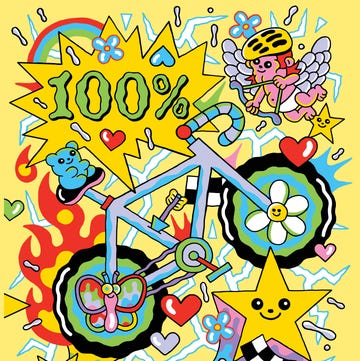It happens to most home mechanics at one time or another in their cycling life—you’re halfway through a bike repair when you realize you are in over your head.
DIY bicycle maintenance and repair has several upsides. It can be fun, challenging, and rewarding. You learn how your equipment functions on a more granular level. Plus, wrenching on your bike can save you money that you can put towards other needed cycling gear, upgrades, trips, or event entry fees. (Or extra cappuccinos at your mid-ride coffee stops.)
However, working on your bike can also be overwhelming, particularly if you lack the prerequisite experience, necessary tools, or the spare time to complete the project. If this sounds like you, I recommend bringing your bike to a local bicycle shop for professional service.
Know When to Go to a Shop
Only you will know if a project is beyond your skills or time limitations. And this often depends on the situation. While you might be comfortable working on wheels but not suspension, someone else might prefer bringing every adjustment to a shop because they have a busy schedule or lack the space in their apartment or house to perform bike maintenance.
This even happens to those of us well-versed in bicycle repair. I worked as a shop mechanic throughout college and again at the height of the pandemic-fueled bike boom of 2020. I also had product development roles with bicycle companies for two decades and assembled countless prototype bikes. Over the years, I also assisted team mechanics in the paddock at mountain bike World Cups and worked the pits for friends at UCI cyclocross races.
Yet, even with my knowledge and experience, I will gladly pay a shop to perform some jobs rather than tackle them myself. Some repairs require tools I don’t own, while other maintenance is time-consuming and I’d prefer spending those spare hours on the road or trail instead of at the repair stand.
Before beginning a repair, maintenance, or component installation, study the process to know what lies ahead. Be sure you are familiar with the parts and have all the necessary tools and supplies before starting. Also, ensure you have the time to do it—repairs usually take longer than you think, especially when doing something for the first time. That ten-minute job in a YouTube tutorial can easily spiral into a multi-hour affair.
For some repairs, the price of a bike shop doing the work costs far less than the potential broken parts, specialty tools, or headaches and frustration. Plus, it is peace of mind that the job gets done right the first time.
Repairs and Service to Avoid at Home
Below are several repairs and services Bicycling’s editors and test staff recommend bringing to a shop versus performing at home. These suggestions are based on our experience—and sometimes personal mistakes. And remember, don’t let these recommendations dissuade you from trying a new or challenging repair if you have the ambition, skill, correct tools, or time.
Brake Bleeds
Hydraulic disc brakes are now standard equipment on bikes of all categories and prices. If your bicycle features hydraulic brakes they will eventually require service. Changing disc brake pads or installing rotors is straightforward—most home mechanics will not have problems doing this work. However, many riders find bleeding disc brakes or installing new brake hoses beyond their skill level.
Bleeding hydraulic brakes isn’t too challenging—if you follow the steps exactly and use the right materials, it usually goes according to plan. (Though sometimes it can be messy.) Different brands and brake models require specialty bleed tools and specific brake fluid. And each brake model can have unique bleed procedures. Plus, many professional mechanics have secrets and tips to make each system shine.
If you are uncomfortable doing this yourself (or are not good at following directions to a tee), bring your bike to a shop for hydraulic brake service.
Cutting a Steerer Tube
Measure twice; cut once. Not following this age-old proverb has plagued home bike mechanics for generations. Once material is removed from a component it cannot be put back on, so ensure you are right the first time.
Unlike trimming the length of your mountain bike bars or seatpost, a fork’s steerer tube—the part your stem attaches that passed through your headset—cannot be replaced if you cut it too short for your liking. If you need a longer steerer tube down the line (for example, if your bike fit changes or you want to raise your stem) it means replacing the entire fork. This can be costly if your bike has a suspension or proprietary fork.
If your fork’s steerer is cut too short and doesn’t allow the stem to clamp fully, it can damage your frame or cause injury. Additionally, carbon steerer tubes require more care when cutting than aluminum or steel. Let your local shop do this repair.
Bike Fits
Getting properly fit for your bike is one of the best upgrades for riding enjoyment and performance. While apps and online services exist, I recommend getting an in-person bike fit. An in-person session with a professional bike fitter costs more than an online fit—but it’s worth the money for the personalized service and attention to detail. Bike fitters usually will make adjustments for you so you can try different positions. And since they are with you in person, a professional will notice details that AI can’t see.
Removing a Seized Seatpost
Stuck seatposts are usually caused by corrosion of dissimilar metals or materials. Sweat, road spray, or water from washing your bike slowly penetrates and causes the post and seat tube to become best friends. Failing to grease an aluminum post in an aluminum or steel frame, not applying ti-prep to a post in a titanium frame, or neglecting to apply carbon paste when installing a post in a carbon frame, can result in a seatpost becoming seized in your frame. This usually does not happen overnight; it can take months or years.
You can try using some penetrating fluid to get it loose. But head to a shop if it doesn’t break free on the first or second application. The post probably needs some extra coaxing to be removed. Chances are that your local bike shop has removed a stuck post on many occasions—they have some methods to get it loose without damaging your frame.
Installing Fenders
Some projects seem simple at first glance but quickly become more complex than expected. Installing fenders, particularly those sweet-looking metal ones–such as models from Velo Orange or Sim Works—is a prime example of an upgrade that can become a time suck.
Full-coverage fenders must be properly sized for your bike and tires. A common mistake is purchasing and attempting to install the wrong fenders—this can prove costly if the fenders require drilling or cutting. I recommend riders work with a shop to buy and set up fenders on their bike. Bike shops (especially those specializing in commuter or touring bikes) have fender installs down to a science. This will save you time and frustration. Plus, your bike will come out of the shop looking perfect.
However, I should heed my own advice. I recently installed custom-anodized, $1,000 No.22 titanium fenders on my Firefly Gravel bike—it took me much longer than I expected. Although I’ve fit many bike fenders in my lifetime, not doing it for a few years slowed my pace considerably.
Buying Shoes
Many folks are comfortable purchasing shoes online but trying (and buying) shoes in person usually results in a better outcome and ensures they properly fit. This is especially true if you are buying clipless shoes for the first time, are switching brands, or need shoes for a new riding discipline. Buying at a shop allows you to try different styles and compare material details in person that you might miss from photos on a site. Plus, the person helping you in a shop is probably a cyclist who can answer your questions and help with cleat set-up.
Frame Repair
Bikes can be damaged in crashes, collisions, or accidents (like forgetting a bike on your roof rack). Sometimes frames crack from use or when traveling. Depending on the location of the damage, the frame can be repaired and doesn’t need to be scrapped.
While a few companies sell DIY carbon repair kits, I highly recommend having any frame repairs performed by professionals. Appleman and Ruckus Composites are two of several specialist companies in the U.S. that evaluate and repair carbon fiber bikes.
Facing and Chasing
When you purchase a complete bike, the disc brakes, bottom bracket, and headset are pre-installed. Bike manufacturers usually make sure the surfaces where these parts attach are level and free of paint overspray. When you buy a frameset, the surfaces often need preparation before components are installed (and sometimes factories miss areas on a complete bike).
The tools required to face frame surfaces and chase threads are pricey—Park Tool’s BTS-1 bottom bracket tapping and facing set costs $820. Since a frame only needs this service once, pay a shop to do it for you.
Installing a Headset
Many riders upgrade their bike with a nice aftermarket headset—Chris King, Wolf Tooth, and Cane Creek are popular choices. While drop-in style headsets are common on modern bicycles, many bikes use traditional press-in cups to hold the headset bearings. You probably do not want to risk damaging your frame or parts by using a block of wood and a mallet to install your shiny anodized headset. Since a good shop-quality headset press is expensive, and some headsets require special adaptors to install, have a local shop do this job.
Suspension Service
If your bike has a suspension fork or rear shock, these parts will eventually require service. Check the suspension maker’s manuals or websites for service intervals (RockShox recommends service every 50 hours of riding). Depending on how much you ride, this might be work you want to learn as it can save you money over time. However, leave this service to the professionals if you do not have the space, time, or tools to tear down and rebuild your fork or shock. Several suspension shops allow you to ship your components for rebuild and many mountain bike-oriented shops can perform this work in-house.
Wheel Building
Building wheels from scratch was once a right of passage for mechanics. It requires time, patience, know-how, and a few specialty tools. But this art has quickly fallen out of style in the age of pre-built, super-durable wheelsets.
Many riders now purchase pre-assembled wheelsets since the cost is usually much less than buying the individual parts (rims, hubs, spokes, and nipples) and paying the labor for shop-built wheels. But if your bike has a specific fitment need, you are reusing existing hubs, or you want something unique, you need to get wheels built. Let the experts at your shop handle this project to ensure it is done correctly and you end up with a great wheel.
Gluing Tubulars
Tubular tires are a remnant of a bygone cycling era. Not long ago, many bike racers and performance-oriented cyclists preferred tubulars—a type of tire glued to the rim with an inner tube built in—due to their superior ride quality and lightweight. However, high-performance clinchers and tubeless tires became the norm over the past ten to fifteen years as brands reduced tire weights, and durability and ride quality improved. (Disc brakes also allowed for wider rims and tires).
Now, tubulars are mainly used by professional cyclocross racers and on track racing bikes. Installing tubular tires requires skill, prep work, time, and special glue, it’s a job I recommend passing off to a shop or mechanic with experience in the craft. Paying for properly glued tires beats rolling a tub in the first corner because you want to save some cash.
As Deputy Editor, Tara Seplavy leads Bicycling’s product test team; after having previously led product development and sourcing for multiple bike brands, run World Championship winning mountain bike teams, wrenched at renowned bicycle shops in Brooklyn, raced everything from criteriums to downhill, and ridden bikes on six different continents (landing herself in hospital emergency rooms in four countries and counting). Based in Easton, Pennsylvania, Tara spends tons of time on the road and trail testing products. A familiar face at cyclocross races, crits, and bike parks in the Mid Atlantic and New England, on weekends she can often be found racing for the New York City-based CRCA/KruisCX team. When not riding a bike, or talking about them, Tara listens to a lot of ska, punk, and emo music, and consumes too much social media.


























